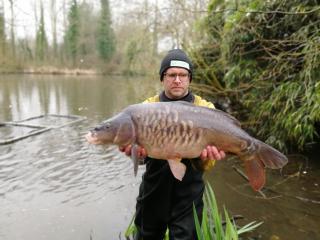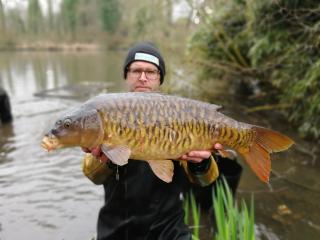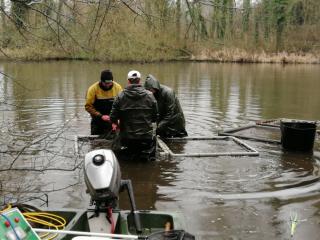Report on the Broadwater netting/ electro fishing exercise undertaken by 5 Star fisheries management on the 15th and 16th March
Biomass The total biomass of the lake at the time of the operation is estimated at between 6,000 and 6,500 pounds. This is based on the netting on the 15th March and a comprehensive electro fishing operation on the 16th that covered the bird feeding area, the shallow Western end of the lake and the bank and island margins.
An echo sounder identified the main concentration of fish on the 15th as being to the east of the island down to the road bank. This was fished with a 410m net and yielded just over 3,000lb of fish. These were retained in holding nets.
Electro fishing of the bird feeding area produced about 800lb of fish. In total 426 carp were surveyed which 5 star estimated to be the main population of the lake. As we saw at Marsh Farm doing a combination of netting and electro fishing works well and the echo sounder confirmed that there were no big concentrations of fish left in open water. Even so there are always some fish that escape the net or get too tight to the bank during the electro fishing. 5 Star allowed an extra 20% to cover missed fish when calculating the total biomass.
This is down slightly on the last biomass estimate of over 7,000 pounds and confirms that Broadwater does not have the super density of carp many imagine.
Most of this biomass is carp. Some decent quality roach taken in the netting – maximum 50lb total – with more showing up when electrofishing the margins. Most perch were found electrofishing the bird feeding area and margins with some good fish (2 ½ lb +) seen. One crucian and a few rudd showed and one ornamental goldfish. No tench were found and no exotic species like catfish.
Fish condition. The survey showed fish conditions ranging from pristine to poor. In total 426 carp were assessed either through netting or electro fishing. Of these 10- 15% could be classed as pristine. There are some pictures of these fish with this report. They are stunning. 94 fish - 22% of the sample - were in poor condition. This leaves the majority of fish-63-68 % of the stock showing one or more of these problems but considered in good enough condition to feed normally and regain condition.
Common problems include:
1) Weight. Many of the fish show signs of undernourishment. Given their age and strains no fish are attaining their potential weights. It is likely that fish are caught easily in Broadwater not because of the high biomass but because of hunger. However not all fish show signs of undernourishment. Some, particularly younger fish, are perfectly proportioned and look fit.
2) Parasite load. Of greatest concern is the prevalence of Ichyophthirius multifilis, or white spot. This is a parasite that attaches itself to the fins, gills’ and mouth of fish. It looks rather like a dusting of salt. The main causes of infestation are stress and poor water quality, both of which are linked in the case of Broadwater. Argulus was also noted on some of the fish.
3) Damaged mouths. This was a feature of many of the fish in poor condition. They showed signs of Jaw incisions, barbule damage, split lips or lip absence. The worst of these fish have lost the ability to feed properly relying on filtering rather than sucking to feed.
4) Fin damage. There is evidence of fin damage on some but not all of the fish.
5) Predation damage. The silver fish show clear signs of predation damage and there is an absence of juvenile carp in the water, at least partly caused by predation.
Fish removal The fish caught by both electro fishing and netting have been graded with only the most damaged fish selected for removal. The main criteria used for selection is their ability to feed properly. Each fish was double assessed – once at the initial grading and again at either their release back into the lake or selection for removal. 136 fish were graded poor after the first selection but following the second assessment this number dropped to 94. The fish were collected by a fish farmer from Newark who drove down specifically to collect them.
The 94 fish selected for removal to Newark represent 17.3% of the estimated biomass of the lake. Not all fish were assessed so anglers will still catch some fish in poor condition. 5 Star feel that removing the poorest fish will reduce pressure on food for those remaining and lower the parasite load by removing weak host fish.
Management recommendations
1) Improving water quality. There is a lot of work needed done on water quality at Broadwater. As a start 5 Star recommend applying silltex annually to reduce the silt build up and improve the habitat for invertebrates.
2) Feeding. The fish would benefit from supplementary feeding with medicated pellets. Some anglers may worry about supplementary feeding filling fish up so they don’t take anglers baits. 5 Star advise us that supplementary feeding tends to do the reverse as fish put on weight and are in better condition generally so they should feed better as a result.
3) Stocking. Five Star recommend leaving the water for this season to see how it responds tothe fish removal, fish feeding and siltex application. Together these improvements should improve water quality and reduce the parasite load by thinning out host fish. Once conditions improve- hopefully by winter 2022-23- look to introduce some new fish.
4) Longer term improvements. There are a number of improvements in the longer term we can look to make around the lake. For example: discuss with Waverley moreabout reducing the tree cover around the lake to reduce leaf build up, look at the inflow stream andsome better nutrient filtration between the stream inflow and the main lake, try to reduce the suspended solids so some vegetation could be re-established.
Conclusion. The fisheries management operation run by 5 star has highlighted problems that we have been aware of but not tackled at Broadwater for some time. We now know that the fish is not seriously overstocked and the fish are generally not thriving as they should. This operation confirms that we have challenges with water quality and outlines strategies that we need to take if things are to improve- which they certainly can do. Thanks to Ben and the team- Andy and Josh- for their hard work and expert advice and all the Godalming team and particularly Bill, Colin, Dave B and Dom for their help over the operation.

Added by Dave Ewing on December 18, 2025

Added by Dave Ewing on December 13, 2025

Added by Dave Ewing on December 07, 2025

Added by Dave Ewing on December 04, 2025

Added by Dave Ewing on December 03, 2025

Added by Dave Ewing on December 01, 2025

Added by Dave Ewing on November 27, 2025

Added by Dave Ewing on November 25, 2025

Added by Dave Ewing on November 24, 2025

Added by Dave Ewing on November 14, 2025




